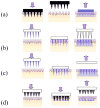Micro-scale devices for transdermal drug delivery
- PMID: 18805472
- PMCID: PMC2752650
- DOI: 10.1016/j.ijpharm.2008.08.032
Micro-scale devices for transdermal drug delivery
Abstract
Skin makes an excellent site for drug and vaccine delivery due to easy accessibility, immuno-surveillance functions, avoidance of macromolecular degradation in the gastrointestinal tract and possibility of self-administration. However, macromolecular drug delivery across the skin is primarily accomplished using hypodermic needles, which have several disadvantages including accidental needle-sticks, pain and needle phobia. These limitations have led to extensive research and development of alternative methods for drug and vaccine delivery across the skin. This review focuses on the recent trends and developments in this field of micro-scale devices for transdermal macromolecular delivery. These include liquid jet injectors, powder injectors, microneedles and thermal microablation. The historical perspective, mechanisms of action, important design parameters, applications and challenges are discussed for each method.
Figures




References
-
- Agerso H, Moller-Pedersen J, et al. Pharmacokinetics and pharmacodynamics of a new formulation of recombinant human growth hormone administered by ZomaJet 2 Vision, a new needle-free device, compared to subcutaneous administration using a conventional syringe. Journal of Clinical Pharmacology. 2002;42(11):1262–1268. - PubMed
-
- Apitz I, Vogel A. Material ejection in nanosecond Er : YAG laser ablation of water, liver, and skin. Applied Physics a-Materials Science & Processing. 2005;81(2):329–338.
-
- Badkar AV, Smith AM, et al. Transdermal delivery of interferon alpha-2B using microporation and iontophoresis in hairless rats. Pharmaceutical Research. 2007;24(7):1389–1395. - PubMed
Publication types
MeSH terms
Substances
Grants and funding
LinkOut - more resources
Full Text Sources
Other Literature Sources
Medical

